Collection of materials relating to neuro-ophthalmology as part of the Neuro-Ophthalmology Virtual Education Library.
NOVEL: https://novel.utah.edu/
TO
Filters: Collection: "ehsl_novel_novel"
1 - 25 of 15
| Title | Creator | Description | Subject | ||
|---|---|---|---|---|---|
| 1 |
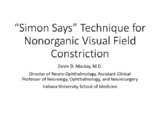 |
"Simon Says" Technique for Nonorganic Visual Field Constriction | Devin D. Mackay, MD | Explanation of the "Simon says" technique. | Simon Says, Visual Field Constriction |
| 2 |
 |
Finger to Nose Perimetry | John Pula, MD | A description of the use of the finger to nose perimetry test is covered. | Non-organic Vision Loss |
| 3 |
 |
Convergence Insufficiency | Shirley H. Wray, MD, PhD, FRCP | The patient is a 73 year old man with a ten year history of idiopathic Parkinson's disease characterized by difficulty in walking, generalized rigidity and a mild tremor of his hands at rest with deterioration in his handwriting. He denied any memory impairment or loss of cognitive function. He was ... | Basal Ganglia; Blepharoclonus; Convergence Insufficiency; Slow Hypometric Saccades; Saccadic Breakdown of Smooth Pursuit; Parkinson's Disease- Dopamine deficiency; Slow Hypometric Horizontal Saccades; Convergence |
| 4 |
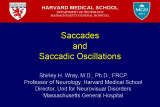 |
Saccades (Guest Lecture) | Shirley H. Wray, MD, PhD, FRCP | The video of the normal eye movement examination was made with the assistance of Dr. Terrence Millette, a neurologist and former Fellow with me in 1985-1986. Introduction to the Saccadic System Saccades are fast eye movements that bring the image of an object of interest onto the fovea. They consist... | Normal Eye Movements; Examination, Ocular; Saccades; Optokinetic Nystagmus Drum (OKN Drum); Pursuit; Ocular Motility |
| 5 |
 |
Paraneoplastic Anti-Hu and Anti-CV2 Positive Ataxic (Cerebellar and Sensory Ganglionopathy) Encephalitis | Anuj Rastogi; Rahul Sharma; Gustavo Saposnik; Alexandra Muccilli | We describe a case of an elderly man with Non-small Cell Lung Cancer, presenting with paraneoplastic Anti-Hu and Anti-CV2 positive encephalitis. He had both cerebellar ataxia and sensory ataxia, likely from the paraneoplastic induced cerebellar degeneration and sensory ganglionopathy, respectively. ... | Anti-CV2; Anti-Hu; Ataxia; Cerebellar Ataxia; Encephalitis; Nystagmus; Sensory Ganglionopathy |
| 6 |
 |
Tonometry | Ore-ofe Adesina, MD | Presentation covering the measurement of intraocular pressure, Tonometry. Covers indentation, applantation and electronic tonometry. | Tonometry; Intraocular Pressure |
| 7 |
 |
Thalamic Infarct | Shirley H. Wray, MD, PhD, FRCP | The patient is a 64 year old man with no major past medical history who, on the day of admission, suddenly developed loss of vision in both eyes and then was unable to open his eyes on his own unless he used his hands. Holding his eyelids open his vision was very blurry. Within minutes he lost consc... | Somnolence; Bilateral Ptosis; Supranuclear Paralysis of Downgaze; Vertical Oculocephalic Reflex Normal; Absent Convergence; Horizontal Gaze Evoked Nystagmus; Top of the Basilar Syndrome; Artery of Percheron; Thalamic Infarct; Supranuclear Paralysis of Downgaze Infarct; Thalamus Infarct; Downgaze Pal... |
| 8 |
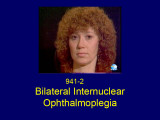 |
Bilateral Internuclear Ophthalmoplegia | Shirley H. Wray, MD, PhD, FRCP | This patient was seen at the Yale Eye Center at the age of 37. She had a long history of multiple sclerosis. At age 22, she had an acute attack of optic neuritis in the left eye which recovered fully within three weeks. Some months later she had a recurrent episode in the same eye, which also recove... | Bilateral Internuclear Ophthalmoplegia; Pendular Horizontal Oscillations; Lid Nystagmus; Upbeat Nystagmus; Botulinum Toxin Therapy; Multiple Sclerosis; Horizontal Pendular Nystagmus; Gaze Evoked Upbeat Nystagmus; Abducting Nystagmus |
| 9 |
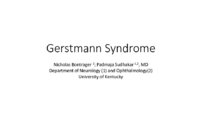 |
Gerstmann Syndrome | Nicholas Bontrager; Padmaja Sudhakar, MD | Gerstmann syndrome refers to a constellation of four neurologic deficits: agraphia, acalculia, finger agnosia , and left-right disorientation. All symptoms must be present for a diagnosis of true Gerstmann syndrome. | Gerstmann Syndrome |
| 10 |
 |
Paraneoplastic Ocular Flutter | Shirley H. Wray, MD, PhD, FRCP | The patient is a 58 year old woman with known hypertension. In 1994, two weeks prior to admission she had a dramatic change in behavior with insomnia, agitation and depression. This was accompanied by "ringing of hands and anxiety for no apparent reason". She became anorexic, lost 15 pounds in weigh... | Ocular Flutter; Oscillopsia; Trunkal Ataxia; Paraneoplastic Cerebellar Syndrome; Small Cell Carcinoma of the Lung; Paraneoplastic Ocular Flutter; Flutter |
| 11 |
 |
Neuroblastoma | Shirley H. Wray, MD, PhD, FRCP | The patient is Case 27-1995 Case Records of the Massachusetts General Hospital (New Eng. J Medicine 1995, 333:579-586). The discusser was Dr. Elizabeth Engle, Associate Professor of Neurology, Harvard Medical School. The baby girl was born after a 30 week gestation, with a birth weight of 1.25 kg. T... | Downbeat Nystagmus; Paraneoplastic Opsoclonus; Neuroblastoma; Primary Position Downbeat Nystagmus; Ataxia; Paraneoplastic Downbeat Nystagmus |
| 12 |
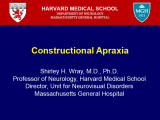 |
Constructional Apraxia | Shirley H. Wray, MD, PhD, FRCP | The patient is a 72 year old right handed woman who presented in November 1995 with the sudden onset of impaired coordination of visual and motor skills following an inner right ear infection. One of her problems was difficulty sitting on a chair as she tended to place her body incorrectly. By late ... | Dressing Apraxia; Apraxia of the Left Hand; Constructional Apraxia; Right Parietal Lobe; Progressive Lobar Atrophy; Degenerative CNS Disease; Apraxia |
| 13 |
 |
Confrontation Visual Fields - A Concise Guide for Ophthalmology and Neurology Trainees | Stephen C. Pollock, MD | The guide describes the techniques required to competently perform confrontation visual fields. It outlines a basic screening protocol and discusses methods for further defining defects identified during the screening process. A mini-atlas of visual field defects is included as an appendix. | Confrontation Visual Fields; Visual Field Testing; Perimetry; Visual Field Loss; Visual Field Defect; Ocular Examination; Visual Sensory Evaluation; Neurologic Examination |
| 14 |
 |
The Mental Status Examination - Cognitive | James R. Bateman, MD, MPH; Victoria S. Pelak, MD | Introduction to the cognitive mental status examination. See accompanying videos: Executive function: https://collections.lib.utah.edu/ark:/87278/s6bw1rp1, Limb-Kinetic apraxia: https://collections.lib.utah.edu/ark:/87278/s63c084b, Ideomotor apraxia: https://collections.lib.utah.edu/ark:/87278/s674... | Mental Status; Cognitive Function |
| 15 |
 |
The Mental Status Examination | James R. Bateman, MD, MPH; Victoria S. Pelak, MD | Introduction to the mental status examination. See accompanying videos: Executive function: https://collections.lib.utah.edu/ark:/87278/s6bw1rp1, Limb-Kinetic apraxia: https://collections.lib.utah.edu/ark:/87278/s63c084b, Ideomotor apraxia: https://collections.lib.utah.edu/ark:/87278/s67410xj | Mental Status |
1 - 25 of 15
